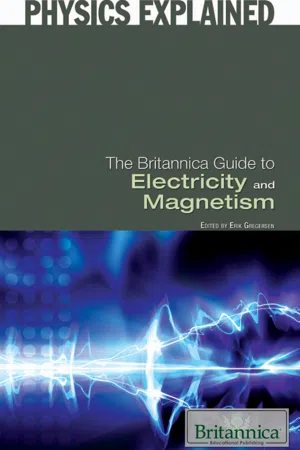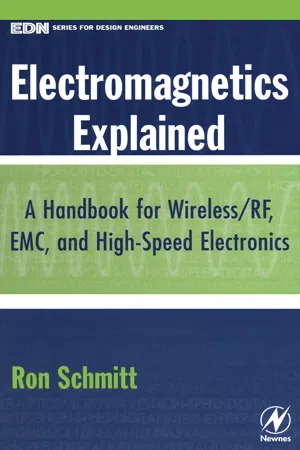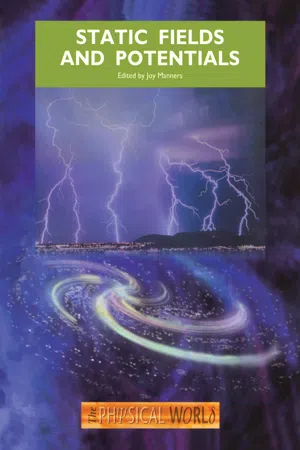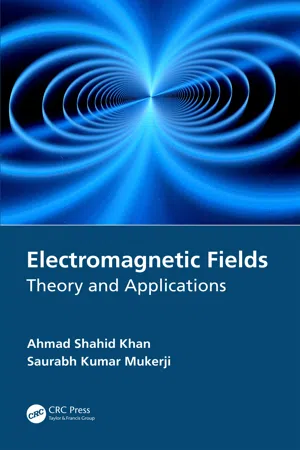Physics
Magnetic Fields
Magnetic fields are regions around a magnet or current-carrying conductor where magnetic forces are experienced. They exert forces on other magnets and moving charges, and their strength and direction can be represented by magnetic field lines. The Earth also has a magnetic field, which is important for navigation and protects the planet from solar wind.
Written by Perlego with AI-assistance
Related key terms
Related key terms
1 of 4
Related key terms
1 of 3
10 Key excerpts on "Magnetic Fields"
- eBook - ePub
- A. L. Stanford, J. M. Tanner(Authors)
- 2014(Publication Date)
- Academic Press(Publisher)
16Magnetic Fields I
Publisher Summary
This chapter discusses magnetism, which refers to a group of phenomena that result from forces acting on charges because of the motion of those charges. These magnetic forces exerted on moving charges are usually described in terms of Magnetic Fields in a way that is similar to that of describing forces exerted on static charges in terms of electric fields. Thus, electric fields have their origins in static charges, and Magnetic Fields originate within moving charges. Increasing the charge or speed of the particle or increasing the magnitude of the magnetic field causes a proportionate increase in the magnitude of the magnetic force on the particle. The simple name, magnetic field, is sometimes called by more impressive names such as magnetic induction, magnetic flux density, and magnetic field induction. This frequency, which is independent of the speed of the particle, is sometimes called the cyclotron frequency.Magnetism refers to a group of phenomena that results from forces that act on charges because of the motion of those charges. These magnetic forces exerted on moving charges are usually described in terms of Magnetic Fields in a way that is similar to that of describing forces exerted on static charges in terms of electric fields. Thus, electric fields have their origins in static charges, and Magnetic Fields originate within moving charges.We will describe magnetic forces in terms of fields by considering:1. How the presence of a magnetic field causes force to be exerted on moving charges. 2. How Magnetic Fields are themselves produced by moving charges.16.1 Magnetic Forces on Moving Charges
Just as the electric field E is defined at a point in terms of the force F e = q E on a static charge q at that point, we may define the magnetic field B at a point in terms of a force relationship between the magnetic field and a moving charge. The magnetic field B - Britannica Educational Publishing, Erik Gregersen(Authors)
- 2010(Publication Date)
- Britannica Educational Publishing(Publisher)
CHAPTER 4 MAGNETISMM agnetism is a phenomenon associated with the motion of electric charges. This motion can take many forms. It can be an electric current in a conductor or charged particles moving through space, or it can be the motion of an electron in atomic orbit. Magnetism is also associated with elementary particles, such as the electron, that have a property called spin.FUNDAMENTALS
Basic to magnetism are Magnetic Fields and their effects on matter, as, for instance, the deflection of moving charges and torques on other magnetic objects. Evidence for the presence of a magnetic field is the magnetic force on charges moving in that field; the force is at right angles to both the field and the velocity of the charge. This force deflects the particles without changing their speed. The deflection can be observed in the electron beam of a television tube when a permanent magnet is brought near the tube. A more familiar example is the torque on a compass needle that acts to align the needle with the magnetic field of Earth. The needle is a thin piece of iron that has been magnetized—i.e., a small bar magnet. One end of the magnet is called a north pole and the other end a south pole. The force between a north and a south pole is attractive, whereas the force between like poles is repulsive. The magnetic field is sometimes referred to as magnetic induction or magnetic flux density; it is always symbolized by B . Magnetic Fields are measured in units of tesla (T). (Another unit of measure commonly used for B is the gauss, though it is no longer considered a standard unit. One gauss equals 10−4 tesla.)A fundamental property of a magnetic field is that its flux through any closed surface vanishes. (A closed surface is one that completely surrounds a volume.) This is expressed mathematically by div B = 0 and can be understood physically in terms of the field lines representing B- eBook - ePub
Electromagnetics Explained
A Handbook for Wireless/ RF, EMC, and High-Speed Electronics
- Ron Schmitt(Author)
- 2002(Publication Date)
- Newnes(Publisher)
3 FUNDAMENTALS OF Magnetic FieldsThe other half of electromagnetics is of course the magnetic field. Magnetic Fields are inherently different and more difficult to grasp than electric fields. Whereas electric fields emanate directly from individual charges, Magnetic Fields arise in a subtle manner because there are no magnetic charges. Moreover, because there are no magnetic charges, magnetic field lines can never have a beginning or an end. Magnetic field lines always form closed loops.You may have heard that some particle physicists have been searching for magnetic charges (or “magnetic monopoles,” as the particle physicists call them) in high-energy experiments. In fact, many unified theories of physics require such particles. However, at this point such particles have not been found. Even if they were to be found, they would be so rare as to be inconsequential to everyone except the particle physicists and cosmologists. Instead of hoping for magnetic charges to bail us out, you need to just accept the fact that Magnetic Fields are inherently different from electric fields. In Chapter 6 , when you learn about relativity, you will learn how the magnetic and electric field phenomena are related in the same manner as space and time. Just as space and time are very different but taken together form an interwoven entity, so do the electric and Magnetic Fields.MOVING CHARGES: SOURCE OF ALL Magnetic Fields
Without magnetic charges, Magnetic Fields can only arise indirectly. In fact, all Magnetic Fields are generated indirectly by moving electric charges. It is a fundamental fact of nature that moving electrons, as well as any other charges, produce a magnetic field when in motion. Electrical currents in wires also produce Magnetic Fields because a current is basically the collective movement of a large number of electrons. A steady (DC) current through a wire produces a magnetic field that encircles the wire, as shown in Figure 3.1 - eBook - ePub
- Clive Maxfield, John Bird, Tim Williams, Walt Kester, Dan Bensky(Authors)
- 2011(Publication Date)
- Newnes(Publisher)
Chapter 21 Magnetic Fields Ron SchmittMagnetic Fields are inherently different and more difficult to grasp than electric fields. Whereas electric fields emanate directly from individual charges, Magnetic Fields arise in a subtle manner because there are no magnetic charges. Moreover, because there are no magnetic charges, magnetic field lines can never have a beginning or an end. Magnetic field lines always form closed loops. You may have heard that some particle physicists have been searching for magnetic charges (or “magnetic monopoles,” as the particle physicists call them) in high-energy experiments. In fact, many unified theories of physics require such particles. However, at this point such particles have not been found. Even if they were to be found, they would be so rare as to be inconsequential to everyone except the particle physicists and cosmologists. Instead of hoping for magnetic charges to bail us out, you need to just accept the fact that Magnetic Fields are inherently different from electric fields.21.1 Moving Charges: Source of All Magnetic Fields
Without magnetic charges, Magnetic Fields can only arise indirectly. In fact, all Magnetic Fields are generated indirectly by moving electric charges. It is a fundamental fact of nature that moving electrons, as well as any other charges, produce a magnetic field when in motion. Electrical currents in wires also produce Magnetic Fields because a current is basically the collective movement of a large number of electrons. A steady (DC) current through a wire produces a magnetic field that encircles the wire, as shown in Figure 21.1 .Figure 21.1 Magnetic field lines surrounding a current-carrying wireA single charge moving at constant velocity also produces a tubular magnetic field that encircles the charge, as shown in Figure 21.2 . However, the field of a single charge decays along the axis of propagation, with the maximum field occurring in the neighborhood of the charge. The law that describes the field is called the Biot-Savart law - eBook - ePub
- Joy Manners(Author)
- 2020(Publication Date)
- CRC Press(Publisher)
I experienced a miracle … as a child of four or five when my father showed me a compass … [I realized] there had to be something behind objects that lay deeply hidden.’The topics covered in this chapter range from the forces between current-carrying wires through to the discovery of the radiation belts surrounding the Earth. However, throughout our exploration of these subjects, one concept will figure prominently — the idea of a magnetic field.The remainder of this chapter is divided into five main sections.- Section 2 is aimed at defining and describing what we mean by a magnetic field.
- Section 3 is devoted to the generation of Magnetic Fields by moving charges.
- Section 4 is an examination of the origin of the startling behaviour of the materials that we call ‘magnetic’.
- Sections 5 and 6 are aimed at describing the motion of charged particles in uniform and non-uniform fields respectively. These will include descriptions of several technological devices and natural phenomena that can be explained using your new understanding.
Figure 4.1 Paper clips attracted to a magnet.2 The magnetic field
2.1 Charged particles in electric and Magnetic Fields
You will recall from Chapter 1 that the field concept was very useful in describing a force that can act at any point within a specified region. In particular, if there is an electric fieldℰ(r) in a certain region such as that shown in Figure 4.2 , then the force on a charge q at position r in the region is given by( r )4.1F el( r )= q ℰ( r ).Equation 4.1 can be used in two ways. A measurement of the force on a known charge serves to define the electric field at that point. Alternatively, if the field is known, it can be used to predict the force on a charge placed in the field. It is important to remember that the electrostatic force acts on all charged particles, whether they are moving or stationary. - eBook - ePub
Electromagnetic Fields
Theory and Applications
- Ahmad Shahid Khan, Saurabh Kumar Mukerji(Authors)
- 2020(Publication Date)
- CRC Press(Publisher)
12 Fields in Magnetic Materials12.1 Introduction
In Chapter 11 , it was noted that irrespective of its nature of distribution, the flow of current results in a magnetic field. To assess this field, certain parameters, referred to as magnetic field quantities (viz. H , B , φ ,V, and A ), were introduced. As fire affects the environment by raising the temperature, so too does the field affect its surroundings, by exerting force on charged particles. The effect of an electric field, discussed in Chapters 5 to 7 , ultimately resulted in force, work done, scalar electric potential, and the energy stored. Similarly, the magnetic field culminates in force, torque, and dipole moment. The material involved in all of the devices comprises tiny charged particles. In the case of an electric field, these particles are also affected by the presence of a magnetic field. Furthermore, their behavior is likely to differ in moving and stationary states. The effect of a magnetic field on charged particles ultimately gets transferred to the matter itself. This chapter therefore deals with different types of materials, which are susceptible to the magnetic field. This chapter also describes the boundary conditions that are to be satisfied by different magnetic field quantities.12.2 Force on Charges and Current
This section deals with the forces exerted on charges and on differential current elements. It also accounts for the force between the current elements.12.2.1 Force on a Moving Charge
As noted earlier both the electric and Magnetic Fields exert force on charged particles. The following subsections indicate the difference between the forces exerted by these two fields.12.2.1.1 Force Due to a Static Electric Field
In Chapter 5 , it was noted that the electric field intensity (E ) exerts a force (F ) on a particle with charge (Q - David V. Guerra(Author)
- 2023(Publication Date)
- CRC Press(Publisher)
6 Magnetic Forces
DOI: 10.1201/9781003308065-66.1 Introduction
If you have ever used a magnet to pick up a paper clip, you have experienced the magnetic force. This force of nature is normally combined with the electric force from the previous chapter into one force of nature called the electromagnetic force. As you read through this chapter, it will become apparent that both these forces, electric and magnetic, are associated with the electrical charge of an object. Therefore, in this chapter, the magnetic force will be computed with the quantities of electrical current and electric charge. Examples of each type of force calculation will be presented and the definition of the magnetic field will be established. The connection between the analyses employed in the study of torques will also be presented to complement and spiral with the sequence of analysis established in the first three chapters of the text.- Chapter question: An MRI (Magnetic Resonance Imaging) is a sophisticated piece of medical machinery that allows doctors to see soft tissue in a way that X-ray cannot. The word magnetic is part of the acronym by which these devices are known, so what is the role of the magnetic in MRI? This question will be answered at the end of this chapter after the concepts of magnetic forces and Magnetic Fields are studied.
6.2 Magnets
The simplest place to start a discussion about magnetic phenomena is a bar magnet, which is most likely some composite of iron, cobalt, and nickel that has been magnetized by placing it near another strong magnet. These metals that hold their magnetic field are called ferromagnets. If a bar magnet, like the one in Figure 6.1 , is split in half, each half will have a north and a south pole.FIGURE 6.1 Magnet poles (N’s and S’s) cannot be separated.If each half is split over and over again, each piece will still have both poles. In fact, atoms, electrons, protons, and neutrons have both a north and a south pole. If we split a magnet in half and then flip one of the magnets, the like poles will face each other, and the magnets will repel. See Figure 6.1- eBook - ePub
Human Exposure to Electromagnetic Fields
From Extremely Low Frequency (ELF) to Radiofrequency
- Patrick Staebler(Author)
- 2017(Publication Date)
- Wiley-ISTE(Publisher)
1 Concepts of ElectroMagnetic FieldsElectroMagnetic Fields are produced from natural and artificial sources. We distinguish between electric, magnetic and electroMagnetic Fields. Whether static or variable in time, they each have physical properties that produce specific interactions with biological organisms: plant, animal and human.To provide a better understanding of the interaction mechanisms, the concepts of electromagnetism and the associated terminology are presented in this chapter [FEY 15].1.1. Concepts of fields
1.1.1. Introduction
In physics, a field can be defined as an area of influence. We are immersed in the Earth’s gravitational field (the area within which the Earth attracts objects) and in electroMagnetic Fields (areas within which we can pick up television broadcasts and mobile phone signals, for example).Gravity acts between two bodies that have a mass, while an electric field acts on positive or negative electric charges (electric charge is a fundamental property of matter, along with mass). These interactions are due to forces whose intensity is proportional to the mass of the objects or to the value of the electric charges. They decrease with the square of the distance that separates them and cancel each other out ad infinitum. The expression of these forces is identical. Their intensity in Newton (N) is given, respectively, by the law of gravitation and by Coulomb’s law (in classical physics):- – law of gravitation between two masses m1 and m2 :
[1.1a ]- – Coulomb’s law between two electric charges q1 and q2 :
[1.1b ]where d is the distance in meters between the two objects, G is the universal gravitational constant, and:Coulomb’s constant (N·m2 ·C–2 ), and “c” is the speed of light (≈ 3 × 10+8 m·s–1 ). εois a constant that will be introduced later on. If we refer to the Earth, FG1/2represents the weight and [1.1a] becomes simply P = m·g with g = 9.81 m·s–2 - eBook - ePub
- Michael M. Mansfield, Colm O'Sullivan(Authors)
- 2020(Publication Date)
- Wiley(Publisher)
19 Interactions between Magnetic Fields and electric currents; magnetic materials AIMS to understand the forces experienced by electric currents in Magnetic Fields to show how such forces may be utilised in instrument design to study the forces on charges which are moving in Magnetic Fields to investigate the nature of magnetic materials 19.1 Forces between currents and magnets Consider the situation shown in Figure 19.1. The current I in the wire produces a magnetic field at the location occupied by a pole of strength p. The contribution to the force on p due to the current I flowing in the element is directed perpendicularly to the page inwards and, from Equation (18.14), is given by From Newton's third law, there will be an equal and opposite force on the element due to the influence of the pole p, which is given by (19.1) and is directed perpendicularly to the page outwards. Let us now change the origin relative to which r is defined so that it is located at the pole p rather than at the element, that is in Equation (19.1). The force on the element due to the pole p is then given by Figure 19.1 The force exerted on the current element by the magnetic pole p is directed perpendicularly to the page outwards if p is an N pole. Figure 19.2 The force on the current element due to a magnetic field of flux density B at the element is given by Equation (19.2). Figure 19.3 The force on a straight length l of wire in a uniform magnetic field of flux density B is IlB sin θ, where I is the current in the wire and θ is the angle the wire makes with the direction of the magnetic field. Now the term in this equation is the magnetic flux density B at the element due to the pole p (recall Equation (18.15)) and hence we may write (19.2) This result describes equally well the force on a current element due to any source of magnetic field since, in the limit, the flux density at the element will be the same as that due to an equivalent single pole - eBook - ePub
Energy Medicine - E-Book
The Scientific Basis
- James L. Oschman(Author)
- 2015(Publication Date)
- Churchill Livingstone(Publisher)
auditory cortex , which enables us to hear the sound.■Energetic interactions between objects are often visualized by means of ‘lines of force’. Several examples of this notion will appear in this and subsequent chapters. The concept of lines of force is thought to have begun with the early research of the English chemist and physicist Michael Faraday (1852), who described the curved patterns traced out in metal filings near a magnet (Figure 2.1A ). Initially, he referred to these as magnetic curves and later called them magnetic lines of force (Figure 2.1B ) or simply lines of force (Fisher, 2004 ). These geometric shapes provide a convenient way of visualizing energy linkages between objects, including electrical, magnetic, gravitational, and electromagnetic interactions. Lines of force have made possible sophisticated mathematical and experimental concepts and theories that will be discussed in this chapter.Figure 2.1 The English physicist Michael Faraday referred to the patterns traced out in metal filings near a magnet (A) as magnetic curves. Later he called them lines of force. (B) Imaginary lines in space that show the nature of the field. The notation has been widely used to describe magnetic interactions (right) and other energetic relationships between objects.Electric, Magnetic, and ElectroMagnetic Fields
Electric charge is a fundamental property of some subatomic particles such as electrons and protons. A stationary electric charge is surrounded by a spherical electric field (Figure 2.2 ). This electric field influences other electrically charged objects. There are two ways of describing the influences of fields and the ways they interact with each other. One perspective is that objects have properties that modify the space around them such that another object entering that space will have a force exerted upon it. A second perspective does not require the concept of force: Objects have properties that modify the space around them such that another object entering that space will experience a change in its motion. In the case of the electron, shown in Figure 2.2
Index pages curate the most relevant extracts from our library of academic textbooks. They’ve been created using an in-house natural language model (NLM), each adding context and meaning to key research topics.
Explore more topic indexes
Explore more topic indexes
1 of 6
Explore more topic indexes
1 of 4









